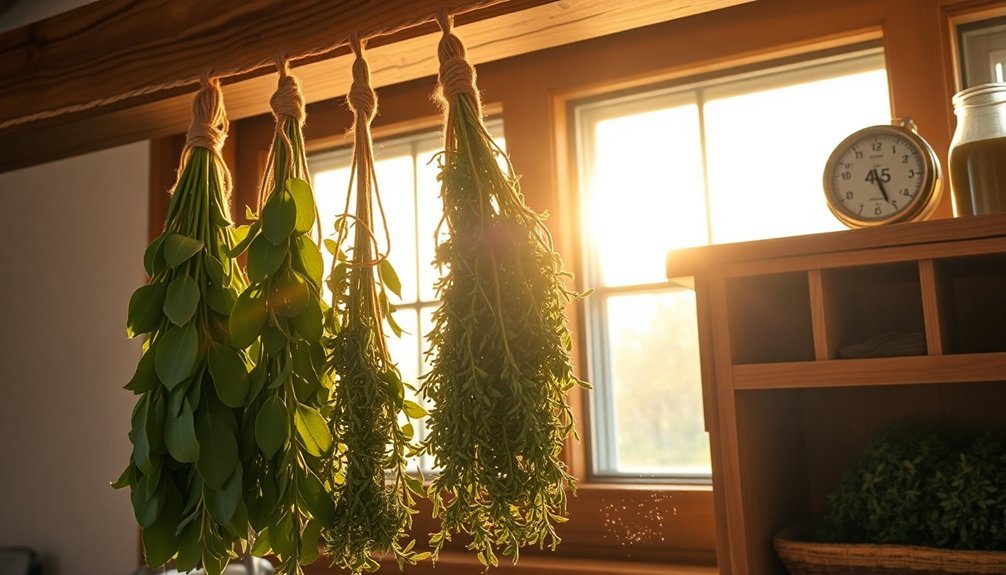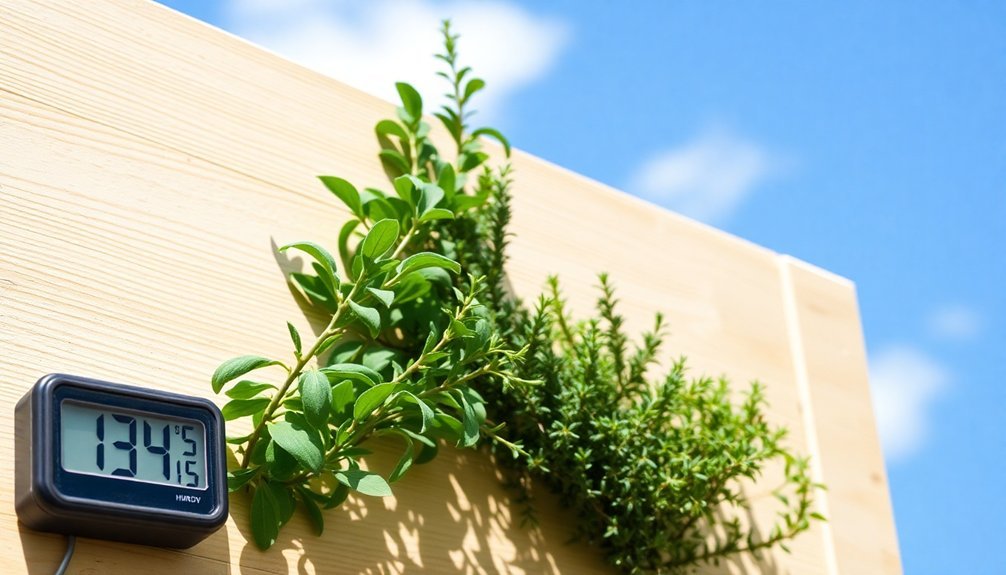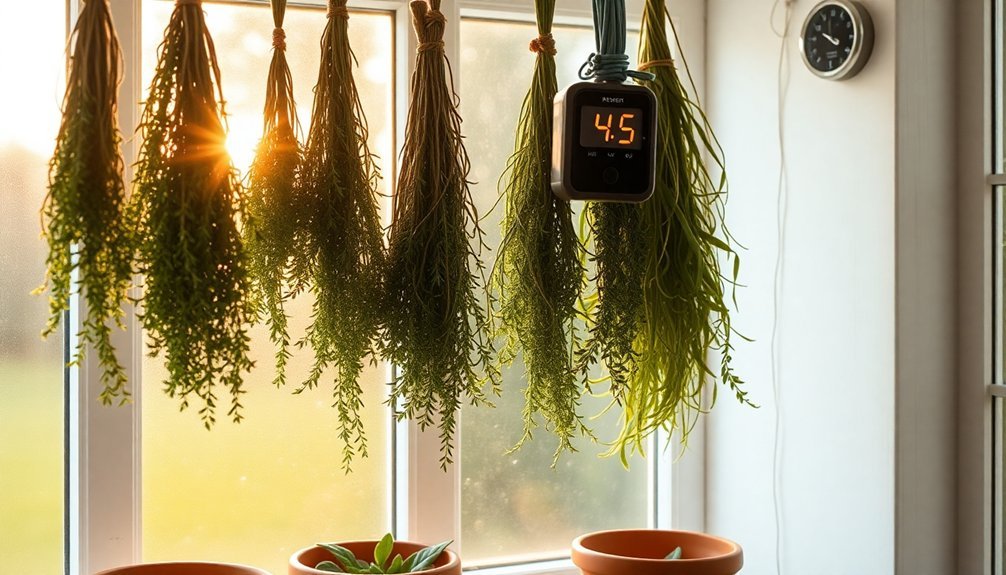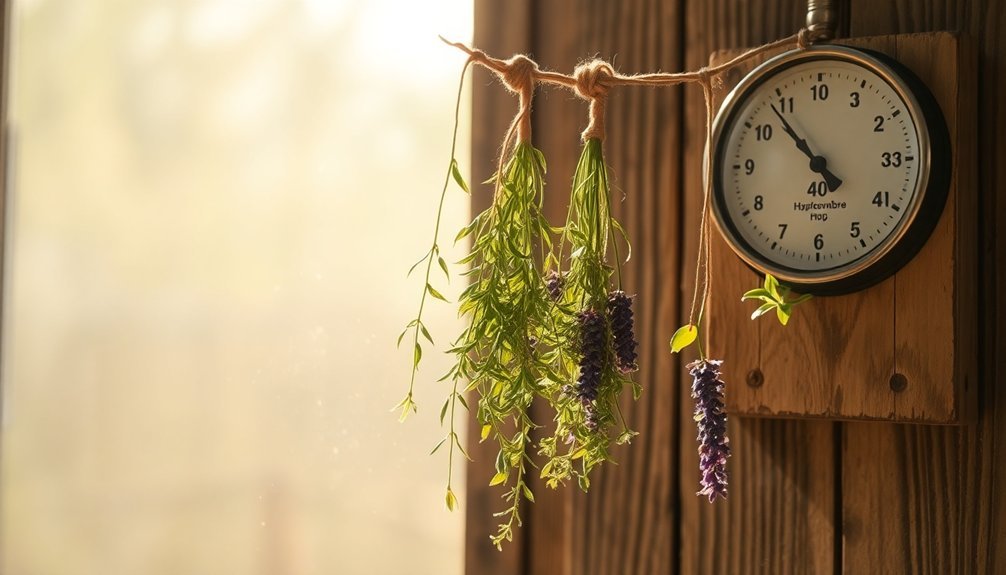When sun-drying your herbs, you'll want to maintain humidity levels between 45-55% for ideal results. Keep the temperature between 90°F and 115°F to guarantee proper moisture evaporation without compromising essential oils. You can monitor these conditions using a simple humidity gauge, which helps prevent mold growth – especially important since levels above 60% increase your risk. Woody herbs like rosemary and sage tolerate higher humidity better than delicate ones like basil and mint. For all herb types, good airflow remains vital to speed up drying time and maintain quality. Understanding these fundamentals will help facilitate your herb-drying success.
Understanding Humidity Fundamentals

Moisture in the air plays a significant role in successfully drying herbs. When you're working with herbs, you need to understand how humidity affects the drying process. Relative humidity (RH) tells you how much water vapor is in the air compared to what it can hold at a specific temperature. For instance, if your drying area has 78.2% RH at 23°C, that means the air is fairly saturated with moisture.
The dew point is essential for your drying process – it's the temperature where water vapor starts condensing. You'll want to keep your herbs in conditions well above the dew point to prevent unwanted moisture from forming on them. According to Dalton's Law, total pressure equals the sum of all partial pressures from different gases in the air, including water vapor.
Remember that warmer air can hold more moisture than cooler air, which directly impacts your drying success.
You'll also need to take into account absolute humidity and mixing ratio. These measurements tell you the actual amount of water vapor present in the air, regardless of temperature.
While relative humidity fluctuates with temperature changes, absolute humidity remains constant unless moisture is added or removed. Understanding these concepts helps you create ideal drying conditions and prevent moisture-related issues that could spoil your herbs.
Measuring Moisture During Drying
You'll need specific moisture testing tools, like an electronic balance or moisture meter, to accurately track your herbs' drying progress.
Regular dryness checks are crucial throughout the day, especially when sun-drying, as moisture levels can fluctuate with changing weather conditions.
The microwave drying method offers a simple and cost-effective way to check moisture content during the drying process.
Testing the moisture content at least twice daily will help you adjust drying conditions and guarantee your herbs reach the ideal 10% moisture level for storage.
Moisture Testing Tools
Professional herb dryers rely on specialized moisture testing equipment to confirm their dried herbs meet quality standards. You'll find several reliable tools to measure moisture content in your drying herbs, with Koster Moisture Testers and Mettler Toledo Moisture Analyzers being among the most popular choices. With decades of experience since 1948, Koster has established itself as an industry leader in moisture testing solutions.
If you're serious about herb drying, you'll want to evaluate a laboratory-grade analyzer that can measure moisture content down to 0.1% accuracy. Mettler Toledo analyzers offer quick results in as little as two minutes using their QuickPredict™ function, while Karl Fischer Titrators provide precise measurements for spices and herbs through moisture extraction methods.
You can easily track and manage your testing data with modern moisture analyzers that feature USB, Wi-Fi, and Ethernet connectivity. These tools store your results in SQL databases, making it simple to maintain quality control records.
When selecting your moisture testing equipment, look for user-friendly features like OneClick™ operation and robust construction that can withstand regular use. You'll find that investing in quality moisture testing tools helps prevent spoilage and confirms your dried herbs meet industry standards consistently.
Daily Dryness Checks Required
Beyond having the right testing equipment, maintaining consistent daily dryness checks forms the backbone of successful herb drying. You'll need to monitor your herbs' moisture content, which should be around 10%, through regular tactile and visual inspections. When properly dried, your herbs should crumble easily and make a rustling sound when crushed between your fingers.
To effectively track your herbs' drying progress, follow these critical check intervals:
- First hour: Check moisture every 15 minutes
- Next two hours: Check every 30 minutes
- Remaining time: Check every 60 minutes
You'll want to pay special attention to your daily evaluations because inadequate drying can lead to serious problems. High moisture content triggers internal enzyme degradation, causing your herbs to brown and lose their active constituents.
Watch for signs that indicate proper dryness – leaves should be crispy and brittle, showing no flexibility or moisture when handled. If you're using the bundling method, examine each bundle carefully and ascertain even drying throughout.
Consider using a paper bag with punched holes to protect your herbs from dust while maintaining proper air circulation during the drying process.
Preventing Mold Growth

Keeping mold at bay starts with proper harvesting and handling techniques for your herbs. You'll want to harvest when herbs are completely dry, avoiding any moisture from rain or morning dew.
Don't wash your herbs before drying unless you're processing roots, as excess moisture creates perfect conditions for mold growth. If you must rinse them, shake off excess water and pat them dry thoroughly.
You'll need to bundle your herbs properly to prevent mold formation. Create small bundles of similar thickness, securing them with rubber bands or thin wire. Hang these bundles in a well-ventilated area, and consider using brown paper bags with holes to protect them from dust while maintaining airflow.
Remove any lower leaves from stems to eliminate moisture pockets.
Monitor your drying herbs regularly, especially in humid conditions. If you spot any signs of mold, remove affected parts immediately to prevent spread.
For challenging environments, you're better off using a dehydrator set between 95°F and 115°F. Avoid sun-drying your herbs, as it not only risks color and flavor loss but also increases the likelihood of mold development.
Creating Optimal Drying Conditions
Creating perfect drying conditions requires careful attention to three key factors: humidity, temperature, and air circulation.
You'll want to maintain humidity levels between 45-55% while keeping temperatures between 90°F and 115°F. If you're in a high-humidity area, you might need to increase both temperature and air circulation to achieve ideal results.
To guarantee successful herb drying, focus on these critical elements:
- Monitor humidity using a gauge or barometer – levels above 60% can lead to mold and poor results.
- Set up an oscillating fan to enhance air movement and speed up the drying process.
- Position your drying herbs away from moisture sources like sinks and dishwashers.
You can improve your drying setup by hanging sturdy herbs in small bundles or laying tender herbs on screens.
For better control, consider using a dehydrator with wire racks or mesh-style surfaces. If you're using natural air-drying methods, cover your herbs with perforated paper bags to maintain airflow while protecting them from dust.
Remember that lower temperatures work best for tender plants, helping preserve their essential oils and vibrant colors.
Regional Humidity Considerations

Regional humidity levels play an essential role in successfully sun-drying herbs. If you're in a low-humidity region with levels below 60%, you'll find sun-drying to be highly effective, preserving both flavor and color. These conditions allow your herbs to dry quickly and evenly, making solar drying an excellent option.
However, if you're dealing with high humidity above 60%, you'll need to adapt your approach. In places like the Pacific Northwest, humidity can create challenges that make herbs susceptible to mold, especially tender varieties like basil and mint. You'll want to increase air circulation and possibly supplement with additional heat sources to combat moisture.
For ideal results, aim to dry your herbs in environments with 45-55% humidity. You can monitor these levels using a humidity gauge to guarantee proper drying conditions.
If you're in an area with consistently high humidity, consider moving your drying operation indoors or using a dehydrator. Woody herbs like rosemary and sage will tolerate higher humidity better than tender varieties, but you'll still need to maintain good airflow.
Remember to adjust your drying methods based on your local conditions, using fans and proper ventilation when necessary.
Storage Environment Requirements
Once your herbs are properly dried, their longevity depends on the right storage environment. You'll need to maintain a consistent temperature of around 68°F (20°C) and keep relative humidity between 40-60% to prevent moisture absorption.
For ideal preservation, store your herbs in dark, closed cupboards away from kitchen activity, sinks, and cooking areas where steam and temperature fluctuations can compromise their quality.
- Choose airtight containers made of glass, metal, or ceramic – avoid plastic as it can leach chemicals. Dark-colored glass jars with screw-top or clamp-on lids are ideal for blocking light and maintaining freshness.
- Keep your herbs away from direct sunlight and heat sources like stoves, ovens, or steamy bathrooms to preserve their potency and color.
- Monitor your storage area regularly using a hygrometer to maintain ideal humidity levels, and verify there's adequate air circulation to prevent mold growth.
When handling your stored herbs, always use dry utensils to avoid introducing moisture.
It's best to store them whole and crush them just before use to retain their essential oils and flavors longer.
Frequently Asked Questions
Can I Dry Herbs Outdoors During Light Rain if They're Under Cover?
No, you shouldn't dry herbs outdoors during light rain, even under cover. The increased humidity from rain will prevent proper drying and could lead to mold. Use a dehydrator or indoor drying instead.
How Do Different Colored Herbs Affect Their Required Drying Humidity Levels?
The color of your herbs doesn't affect their required humidity levels. Instead, focus on the herb's structure – whether it's tender or woody – as this determines the ideal drying conditions between 45-55% humidity.
Does Altitude Impact the Ideal Humidity Range for Drying Herbs?
Yes, altitude affects your ideal herb-drying humidity range. You'll need less humidity control at higher elevations since the air's naturally drier. However, you should still monitor conditions as mountain weather can change rapidly.
Will Using a Dehumidifier Affect the Essential Oil Content of Herbs?
While you're using a dehumidifier, it won't directly affect your herbs' essential oil content. It'll just speed up drying and prevent mold. The main factors affecting oils are temperature and drying duration.
Can Herbs Be Dried Together, or Should Different Varieties Be Separated?
You'll want to separate your herbs when drying. While woody herbs like rosemary and thyme can dry together, keep tender-leaf herbs like basil and mint separate since their different moisture levels can cause mold problems.
In Summary
Proper humidity control is essential when you're drying herbs. Keep your drying space between 30-40% relative humidity and maintain good airflow to prevent mold. You'll know your herbs are ready when they're crisp and crumble easily. Store your dried herbs in airtight containers in a cool, dry place with humidity below 60%. Monitor conditions regularly to guarantee your herbs retain maximum flavor and potency.





Leave a Reply